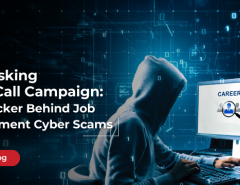Introduction
Cybersecurity threats are incessantly eating into the organizational data reserves, and it is important that CISOs and IT Security Pros keep a close check on the proliferation of hackers and cyber-criminals. While the overall awareness towards cybersecurity is increasing and it has also started getting priority in the organizational strategy, there are often questions that stay unanswered for a vast majority. We have simplified the same by answering a few questions that arise regarding cybercrimes and cybersecurity. Read on to know more!
Q1. What are the Top Reasons for Cyber Attacks?
Answer: Most security breaches emanate out of certain minor weak links which can easily leave organizations vulnerable to subsequent attacks. The first reason is the failure to test the software codes prior to deployment. Untested codes attract malware and other malicious entities that can creep in via multiple entry points. Another reason, leading to specific cyber-attacks is the source code exposure where hackers can bypass password security by predicting the value of session cookies; thereby posing as legitimate users and gaining confidential information.
Most DDoS attacks leverage the reluctance of individuals to reset default passwords. This threat amplifies further when the gadgets are connected to IoT. Company databases can also get compromised when the software vendors fail to apply specific patches. While addressing the technical aspects is essential, it would be wrong to undermine the human errors that can lead to the proliferation of phishing, socially engineered malware and associated ransomware threats. Apart from that, poor control over exfiltration and an organization’s inability to detect infiltration can also lead to industry-wide cyber-attacks.
Q2. What Types of Cyber Attacks should we be aware of?
Answer: To begin with, company CISOs and security professionals must deal with socially engineered malware where the end-user is tricked into visiting a malicious website or running infected programs. In addition to that, we have phishing attacks that are initiated via spam emails. Certain cyber-attacks arise out of software-centric discrepancies with vendors incapable of providing regular patches. Unpatched software modules are essentially the precursors of most ransomware attacks.
Apart from that, there are social media threats with catastrophic consequences. Lastly, we have the Advanced Persistent Threats to deal with which leverage Trojans, phishing attacks, spear phishing and malvertising techniques for spreading infections, far and wide into an organization.
Q3. How do Enterprises Ensure a Robust Security Framework?
Answer: Put simply, a robust cybersecurity framework can keep endpoint invasions and penetrations at bay. The onus is on the company CISOs to ensure the existence of the same by offering vulnerability scanning, penetration testing, and threat modeling plans. In addition to that, a robust security framework also involves vulnerability analysis and assessment clubbed with vulnerability mitigation and remediation plans.
Read more: Setting up a business? Secure it with Seqrite Endpoint Security
Q4. What Features to Look for in a Good Enterprise Security Solution?
Answer: An efficient enterprise security solution must provide a host of possibilities to the concerned organization. When it comes to enumerating the features, Advanced Device Control shows up on top. This involves enforcing policies on the use of portable devices, storage modules, and endpoint connected network interfaces.
Anti-Ransomware is a specific core protection feature which also includes data backup.. DLP or Data Loss Prevention that monitors user defined insights and confidential data is an essential feature when it comes to preventing data loss and thefts. Apart from that, patch management for software and vulnerability scan for assessing the severity of risks are the essential attributes which can render credibility to an enterprise security solution.
Lastly, security service providers like Seqrite also offer features like asset management that focuses on the complete visibility of software and hardware changes followed by their influence on endpoint security.
Q5. As a Startup, do we need to worry about Cybersecurity?
Answer: Although cybersecurity threats can cripple any industry regardless of its size, startups find it extremely hard to recover from the inflicted damages. Small businesses have minimal experience when it comes to putting security solutions to use, and therefore it is easier for the hackers to infiltrate these organizations. Thus, instead of stressing about cybersecurity threats and existing solutions, startups must emphasize on cyber-resilience which signifies the ability of an organization to cope and recover from possible intrusions.
Cybersecurity is a continually evolving topic of discussion. With hackers looking to barge into databases and initiate attacks via newer avenues, it is imperative that CISOs have their concepts clear regarding cyber-attacks, security solutions and everything that aims at keeping the organizational data in safe hands.




